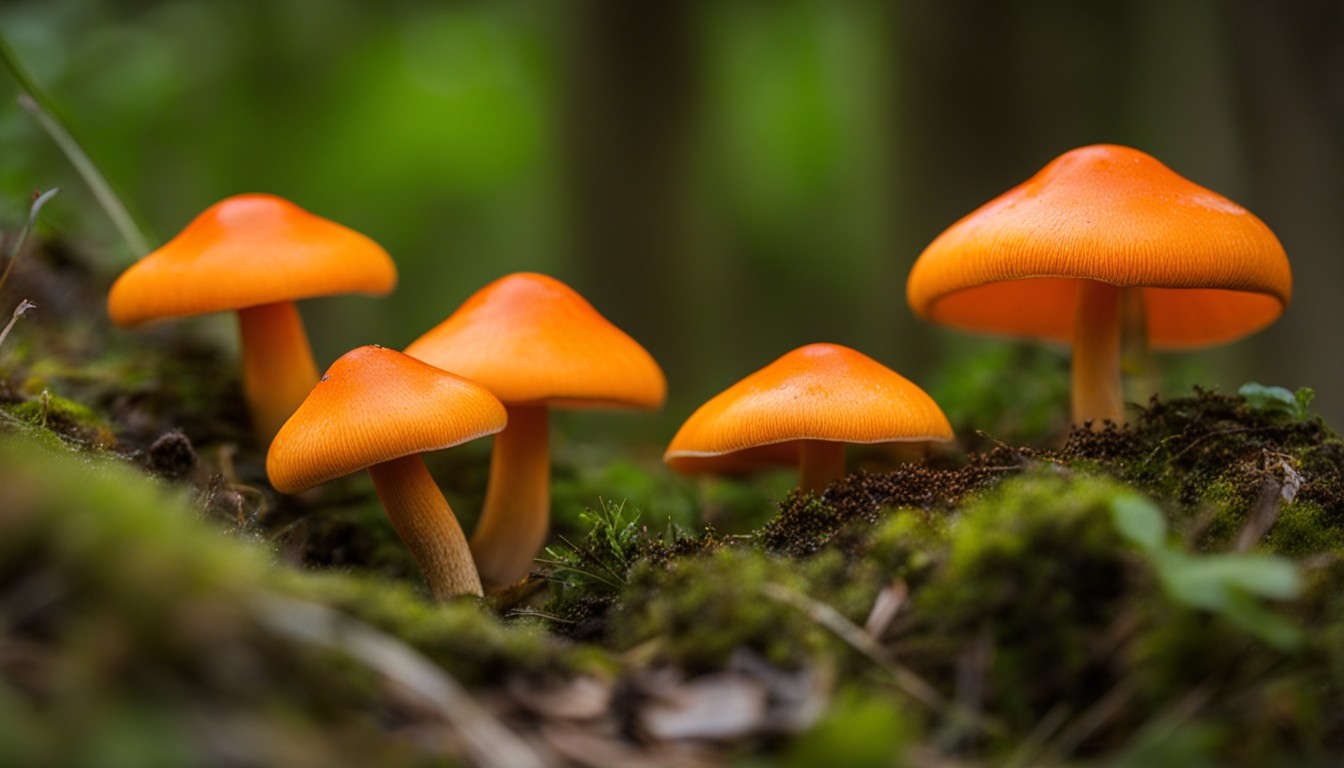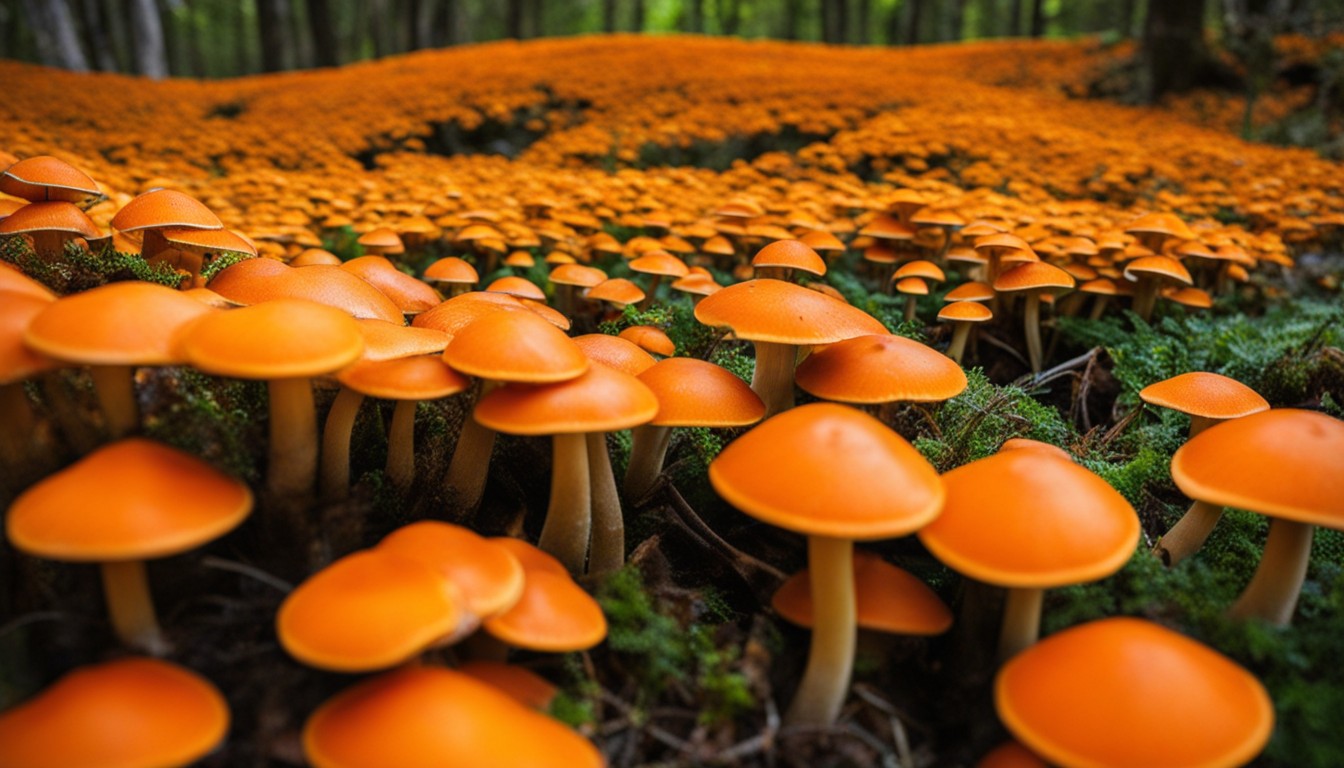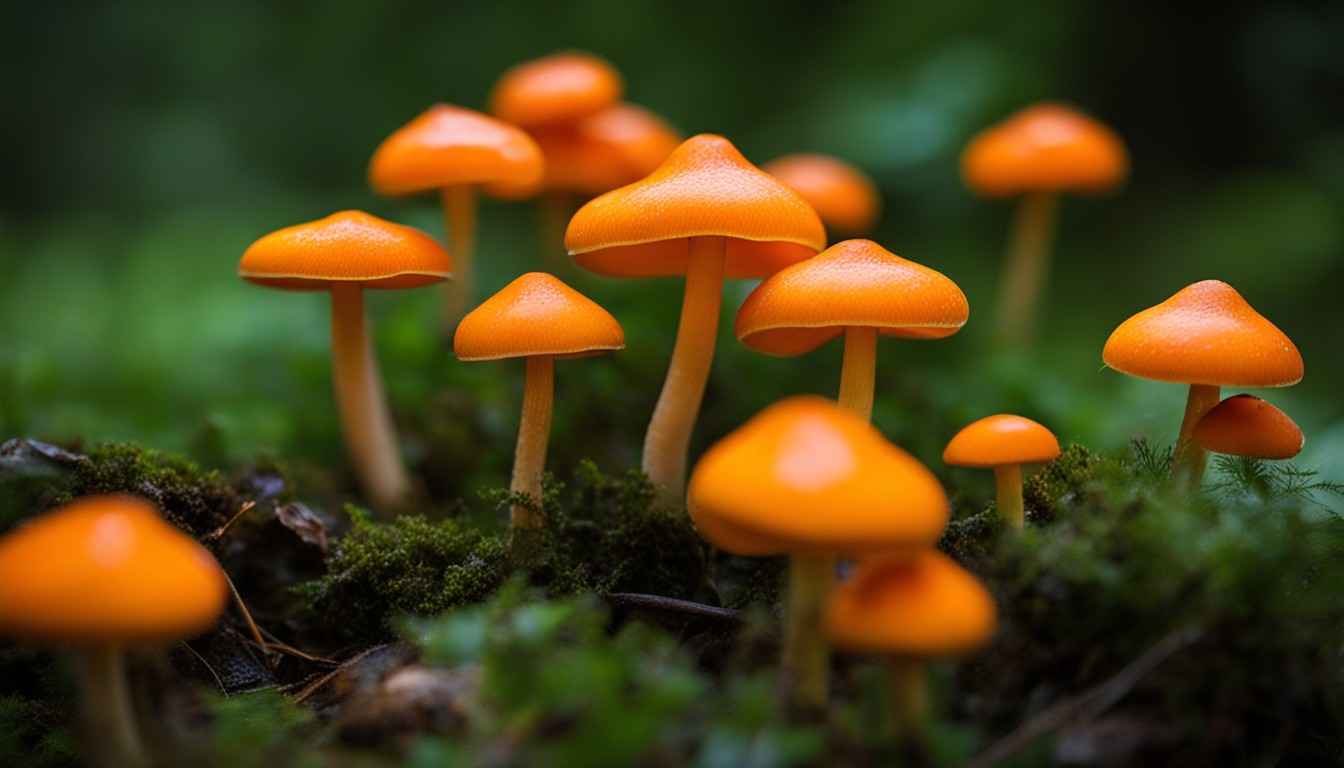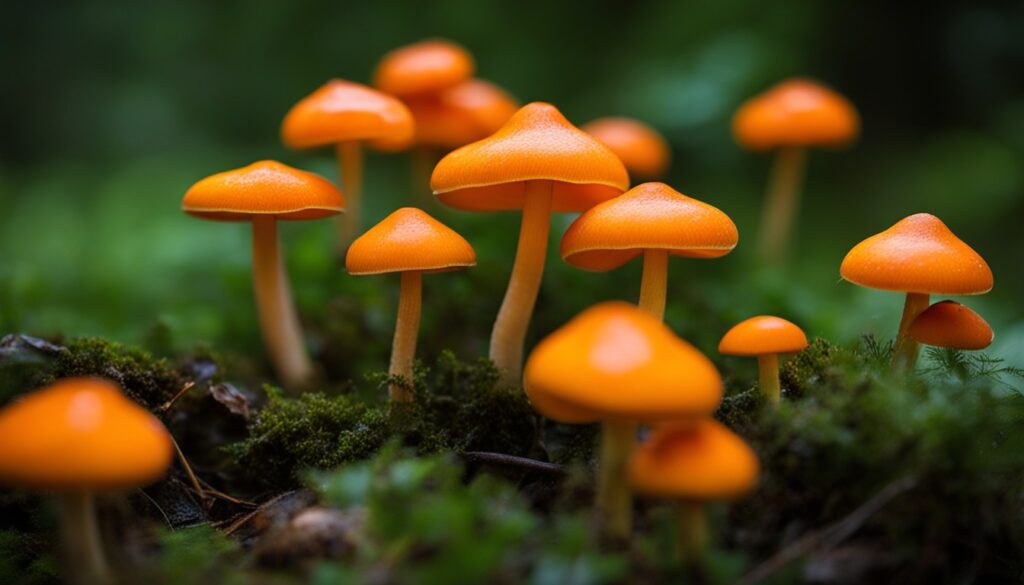Georgia is a diverse state known for its rich biodiversity, including a wide variety of mushrooms. In particular, orange mushrooms have captured the attention of nature enthusiasts and foragers alike. This comprehensive guide aims to provide valuable insights into the different species of orange mushrooms found in Georgia, their identification features, habitat preferences, and potential uses. Whether you’re a seasoned mushroom hunter or simply curious about the natural wonders of Georgia, this guide will equip you with the knowledge to appreciate and explore the world of orange mushrooms in this beautiful state.
What are Orange Mushrooms?
Orange mushrooms, a captivating constituent of the mycology world, stand out owing to their striking hues and varied species. These fungi exhibit unique characteristics which distinguish them amidst other members of the mushroom kingdom.
Venturing into the fascinating realm of mycology, orange mushrooms grip attention not only for their vibrant color but also due to their significance in bio-diversity. A precise identification of these mushrooms can open a gateway to understanding their role in both ecology and human culture.
Characteristics of Orange Mushrooms
Orange mushrooms, named for their vivid hue, possess a range of defining features that make them easily distinguishable amongst the vast variety of fungi.
- Fleshy caps, varying from bright to deep orange
- Veined or gilled undersides
- Stems that are often slender, sometimes displaying a similar coloration to the cap
- A preference for damp environments
- Diverse range in sizes
Common Species of Orange Mushrooms
In Georgia, several species of orange mushrooms can frequently be encountered, each displaying unique characteristics that distinguish them from the others. It’s crucial to familiarize oneself with these common varieties for accurate identification.
- Jack O’Lantern Mushroom (Omphalotus olearius): Recognizable by its vivid orange color and bioluminescence properties.
- Fly Agaric (Amanita muscaria): A bright red-orange cap with distinctive white spots characterize this species.
- Orange Peel Fungus (Aleuria aurantia): As the name denotes, it resembles a scattered peel of an orange.
- Chicken of the Woods (Laetiporus sulphureus): This variety sports bright orange and yellow tiers, similar to the plumage of a chicken.
- Orange Mycena (Mycena leaiana): These are small, orange mushrooms with a slightly slimy cap.
The Importance of Identifying Orange Mushrooms
Identifying orange mushrooms accurately is vital as it determines if they’re safe for consumption or if they pose a risk like allergies or poisonings. In addition, precise identification aids in ecological research, contributing to region-specific data in Georgia and facilitating conservation efforts.
- Informed decision on whether it is safe to touch, consume or use it for medicinal purposes.
- Accurate data for ecological research and biodiversity studies.
- Helpful in conservation planning and efforts to protect local habitats.
- Avoidance of potential harm or allergic reactions.
- Recognition of rare or endemic mushroom species for preservation.
Habitat and Distribution of Orange Mushrooms

Orange Mushrooms in Georgia are often seen flourishing in moist, wooded areas, especially near decaying wood and leaf litter. They have a diverse habitat range extending from the metropolitan parks of Atlanta to the wild forests of the Appalachian foothills.
Orange Mushrooms in Georgia thrive in locations rich in organic matter, moisture, and shade; their habitat spans from Atlanta’s urban parks to the Appalachian forests.
Broadly, the distribution pattern of Orange Mushrooms in Georgia corresponds strongly to areas with high organic matter, adequate moisture and shade. These fungi are largely selective about their habitat, thereby requiring precise conditions for growth and propagation.
Where to Find Orange Mushrooms in Georgia
Exploring Georgia’s diverse landscapes, one can notice the hidden regions teeming with orange mushrooms. Specific locales, distinct for their peculiar climatic conditions and native flora, offer an abundant supply of these enticing fungi.
- The muggy wetlands of the Okefenokee Swamp, rich in detritus and moist soil, serve as a breeding ground for orange mushrooms.
- Within the sprawling Chattahoochee National Forest, towering trees and riparian locales make the perfect habitat.
- The rich soil of agricultural fields and vineyards in North Georgia, supplemented with organic matter, host a variety of orange mushrooms.
- Private gardens and parks in the urban areas of Atlanta, thanks to their well-manicured lawns littered with decomposed wood chips and compost heaps, also provide conducive conditions.
Factors Affecting the Growth of Orange Mushrooms
The flourishing of Orange Mushrooms in Georgia is heavily influenced by the state’s climate conditions, which provide ideal settings, and by the unique attributes of the soil composition and atmospheric factors.
- Impact of temperatures: The sub-tropical climate with hot summers and mild winters in Georgia create an ideal breeding ground for these mushrooms.
- Influence of Humidity: The high humidity levels provide the moisture necessary for the growth and proliferation of orange mushrooms.
- Role of Soil Type: Rich, organic soils, often found in wooded regions of Georgia, promote the bloom of these fungi.
- Effect of Rainfall: Adequate rainfall is crucial as it provides the necessary hydration for the development of the mushroom’s mycelium, leading to a successful fruiting.
- Influence of Atmospheric Pressure: Fungi, in general, respond positively to changes in atmospheric pressure, impacting the mushroom’s lifecycle.
Toxicity and Edibility of Orange Mushrooms

The toxicity and edibility of orange mushrooms vary widely. Some species are edible, like the tasty Jack-O-Lantern, while others, like the Deadly Galerina, contain lethal toxins indicating the importance of correct identification.
Consumption of orange mushrooms unfolds a unique balance between risk and benefit. While edible ones offer culinary delight, incorrect identification can lead to potential health threats, manifesting the critical need for accurate knowledge and caution.
Poisonous Orange Mushrooms in Georgia
Georgia’s woods and prairies host a medley of orange mushrooms, some laden with toxicity. These, like the dreaded Orange Galerina, are as enchanting to the eye as they are dangerous when consumed.
Distinguishing toxic variants requires meticulous attention. Key indicators of poisonous species often include orange hues darkening at the cap’s center, a veil under the cap, and pale gills. Warning: subtleties may be easily overlooked.
For the untrained eye, the beautiful but deadly Deadly Webcap could be confused with its harmless kin. Its warm, tangerine cap might betray its ominous nature, underscoring the importance of precise identification.
Enthusiasts should also be wary of the Jack-o-Lantern mushroom. This variety’s vibrant coloration and clustered growth pattern may attract, but it carries a harmful toxin known as Illudin that causes severe gastrointestinal distress.
Armed with knowledge, foragers can avoid these perilous fungi. Remember, when in doubt, err on the side of caution: Georgia’s orange mushroom’s charm belies the potential danger they can pose.
Edible Orange Mushrooms in Georgia
A culinary adventure awaits those brave enough to explore Georgia’s forest floor for edible Orange Mushrooms. Rich in flavor and abundant in nature, these fungi are a treasured part of Georgia’s gastronomy, seamlessly integrating into many local dishes.
One of the beloved edible species in this region is Laetiporus sulphureus, colloquially known as ‘Chicken of the Woods.’ Its unqiue texture and taste, reminiscent of chicken meat, make this mushroom a popular staple in local meals.
Safety should be paramount when foraging. Ensure that you positively identify any mushroom before consuming it. Also, remember that even edible species can cause allergic reactions in some individuals.
When preparing these mushrooms, clean them thoroughly to remove any dirt or insects. Cooking them thoroughly is also vital as some compounds in raw mushrooms can be hard to digest. Enjoy these gems of Georgia with caution and respect for their habitat.
Identifying Orange Mushrooms
Accurate field identification is crucial as it directly impacts human health and ecosystem balance. Being proficient in identifying Orange Mushrooms prevents accidental ingestion of toxic species and promotes sustainable foraging in Georgia’s diverse fungal flora.
Indispensable for beginners, mushroom identification techniques in Georgia include observing cap shape, spore colour, stalk characteristics, and habitat. This knowledge paves the way to safely enjoy Georgia’s vibrant Orange Mushrooms, while protecting their essential roles in our ecosystems.
Physical Characteristics of Orange Mushrooms
Orange Mushrooms, known for their bright hue, can be identified by a set of distinct morphological traits. Their most distinctive feature is their cap, which is vivid orange, often fading to a lighter tone towards the edge. They have a delicate texture, with a spongy or fruity flesh that’s white and unchanging when sliced.
Another key physical attribute of Orange Mushrooms is their gills. These are typically free or slightly attached to the stem, densely packed, and colored a pale orange or yellow. This is a diagnostic feature of this group and aids with identification.
The stems of Orange Mushrooms are substantial and durable, often slender and colored similarly to the cap or slightly lighter. They may be smooth or exhibit a scaly texture, depending on the particular species.
Lastly, it’s important to note that the spore print, a key identification feature utilized by mycologists, of these mushrooms is usually a vibrant rust to cinnamon shade. This distinctive hue is another reason to believe one may be observing an Orange Mushroom.
Distinguishing Orange Mushrooms from Similar Species
In Georgia, orange mushrooms possess a unique aroma, unlike similar species. This scent, often linked to the region’s terrestrial composition, is a helpful identifying attribute.
Another distinguishing feature of Georgia’s orange mushrooms is the dense scatter of tiny bumps across their caps. Many look-alikes, however, have smoother surfaces.
The stem, or stipe, of Georgia’s orange mushrooms also serves as a critical distinction. These mushrooms tend to have sturdier, longer stems compared to their similar counterparts.
Microscopic spore examination aids in distinguishing orange mushrooms from look-alikes. Georgia’s specific varieties often project a particular spore color and shape.
Moreover, the flesh color, upon bruising, can vary for each species. For some of Georgia’s orange mushrooms, blue to slight green discoloration occurs, a significant differentiating factor from similar species.
Orange Mushrooms in Folklore and Medicine
The vivid hues of the Orange Mushrooms of Georgia aren’t just aesthetically pleasing. They hold significant importance in local folklore and traditional medicine. Long considered as symbols of wisdom and immortality, they continue to be used in herbal remedies.
The Cultural Significance of Orange Mushrooms
In the rich cultural fabric of Georgia, orange mushrooms hold myriad roles; they are featured in folklore, appear in traditional culinary delights, and are even used as natural dye for indigenous fabrics. This varied usage underscores their integral role in the day-to-day lives of Georgian communities.
From a heritage perspective, orange mushrooms tie generations, encapsulating a shared wisdom passed down through the ages, be it for their culinary value, medicinal properties, or other traditional usages. It has endowed them an undisputed position in Georgia’s natural and cultural landscape.
This enduring presence amidst Georgia’s flora elucidates the inherent connection between the population and their environmental resources. The reverence for these vibrant fungi reinforces their conservation, stressing upon the balance between cultural practices and the sustainability of natural habitats.
Medicinal Uses and Benefits of Orange Mushrooms
From ancient times, Georgia’s native Orange Mushrooms have been evaluated for their medicinal properties. Contemporary research points to a rich composition of antioxidants, vitamins, and essential minerals in these fungi, suggesting potential benefits for holistic health.
Orange Mushrooms are also known for their potential anti-cancer properties. Some species contain compounds that inhibit the growth of cancer cells, introducing new avenues for oncological research.
Besides, their potent anti-inflammatory and antibacterial properties make Orange Mushrooms remarkable candidates for natural remedies against numerous health challenges.
Modern medicine is further exploring the therapeutic applications of these mushrooms, including their role in boosting immunity, improving digestion, and managing cardiovascular health, hence further validating their traditional usage.
Conservation and Protection of Orange Mushrooms

Georgia’s Orange Mushrooms are experiencing an environmental crisis, necessitating an immediate and concerted conservation effort.
Employing sustainable harvesting techniques, cultivating awareness, and conducting regular scientific research are key methods to protect the future of Orange Mushrooms in Georgia.
Threats to Orange Mushroom Habitats
Habitat loss, ongoing urban expansion, and climate change comprise the most significant threats to Orange Mushroom habitats in Georgia. These elements pose both direct and indirect harm, diminishing the environments these fungi rely on. These mushrooms need a particular set of conditions for their growth, any fluctuation in these, place their survival in jeopardy.
The relentless urban development and expansion in Georgia not only leads to deforestation and degradation of natural habitats, but also results in extensive soil disturbances. This undermines the integrity of ecosystems wherein our orange-hued fungi reside, threatening their survival.
Climate change also poses a formidable threat to the health and distribution of Orange Mushrooms. Rising temperatures, shifting rainfall patterns, and increasing frequency of extreme weather events drastically modify the ecological equilibrium, disturbing mushroom proliferation.
Heat stress and drought conditions, fueled by global warming, can inhibit mushroom growth and lead to reductions in suitable fungal habitats. Additionally, these changes might influence the symbiotic relationships between orange mushrooms and their host plants. This in turn, impacts their propagation and dispersion.
Conservation Efforts and Best Practices
In a bid to preserve Georgia’s orange mushrooms, both local communities and the government are implementing stringent measures. Their role entails setting up protective zones, conducting research, and educating the public about the importance of these fungi.
As for sustainable harvesting, individuals should only pick a limited quantity from heavily populated areas. Leaving the mushroom roots undisturbed and using a knife to cut the stem further ensures the population’s regeneration and long-term conservation.
Frequently Asked Questions
What types of orange mushrooms can be found in Georgia?
Georgia is home to several types of orange mushrooms, including the popular Jack O’Lantern mushroom, the Chicken-of-the-woods mushroom, and the vibrant Orange Peel fungus.
How can I identify orange mushrooms in Georgia?
To identify orange mushrooms, look for characteristics like their vibrant orange color, curved or funnel-shaped caps, and gilled or pored undersides. It’s crucial to consult a field guide or seek assistance from an experienced mycologist to ensure accurate identification.
Where can I find orange mushrooms in Georgia?
Orange mushrooms can be found in a variety of habitats in Georgia, including deciduous forests, woodland areas, and sometimes even in urban environments. Look for them near tree stumps, fallen logs, or in leaf litter-rich areas.
Are orange mushrooms in Georgia edible?
While some orange mushrooms in Georgia are edible and highly sought after by foragers, it’s essential to exercise caution. Misidentification can lead to poisoning, so it’s advised to consult an expert before consuming any wild mushrooms.
What precautions should I take when foraging for orange mushrooms in Georgia?
Before foraging, educate yourself about mushroom identification by attending workshops or joining local mycology groups. Always carry a field guide, wear gloves, and collect only mature specimens. It’s crucial to practice sustainable foraging to ensure the preservation of these valuable fungi.
Can I cultivate orange mushrooms in Georgia?
Cultivating orange mushrooms is possible, but it requires specialized knowledge and equipment. It is recommended to start with commercially available spore prints or cultures and follow proper cultivation techniques and conditions.
Are there any toxic orange mushrooms in Georgia?
Yes, some orange mushrooms in Georgia are toxic or even deadly if consumed. Examples include the Death Cap and Destroying Angel mushrooms. It is crucial to avoid consuming any wild mushrooms unless you are absolutely certain of their identification.
What is the ecological significance of orange mushrooms?
Orange mushrooms play a vital role in Georgia’s ecosystem as decomposers, breaking down dead organic matter and recycling nutrients back into the soil. They also form mutually beneficial relationships with trees, helping with nutrient exchange and supporting the health of the forest ecosystem.
Can orange mushrooms be used for medicinal purposes?
While some orange mushrooms have traditional medicinal uses, such as the Chicken-of-the-woods mushroom, it’s important to note that consuming wild mushrooms for medicinal purposes should only be done under the guidance of a knowledgeable herbalist or healthcare professional.
How can I contribute to the conservation of orange mushrooms in Georgia?
You can contribute to the conservation of orange mushrooms by promoting responsible foraging practices, participating in citizen science projects, and supporting local initiatives that focus on preserving and studying the state’s diverse fungal communities.
Conclusion
Orange Mushrooms hold a unique place both in the natural landscape of Georgia and in the cultural fabrics of our communities. The need for accelerated conservation actions to protect these fascinating fungi has never been greater.
The journey ahead for preserving the legacy of Orange Mushrooms in Georgia is an invigorating challenge. It involves everyone, from the common citizen to conservation specialists, to partake in actions that promote mushroom growth and diversity.
- Safeguard and restore Orange Mushrooms habitats.
- Promote research focusing on Orange Mushrooms.
- Increase public awareness regarding their importance and the need for conservation.

